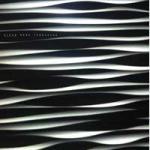
Stern Bone Turquoise
(New Atlantis Records)
In the last decade and a half, New York City has emerged as the new epicenter of eccentric rock with ensembles spiritually emulating the schools of experimental music pioneered by the late 1960s Canterbury sound in the UK, Frank Zappa in the US, and then continued in ensuing decades by West Coast outfits like Thinking Plague and Mr. Bungle. Vocalist and keyboardist Chuck Stern, one of the founding orchestrators of the innovative post-hardcore/math rock/avant-pop band Time of Orchids, has consistently catapulted to the forefront of this new scene in the Big Apple along with fellow prolific bandmates/acolytes, David Bodie (Kayo Dot), Eric Fitzgerald (Infantephant), Jesse Krakow (PAK, Doctor Nerve), and Charlie Looker (Zs, Extra Life, Psalm Zero). Since Time of Orchids' sudden disbandment in late 2007, Chuck has adopted his surname to encompass various atmospherically synth-based explorations that have blended askew harmonic but definitively pop sensibilities with the ominously dulcet drone of famous soundtrack composer Angelo Badalamenti.
In 2012, when Chuck recruited three current members of Kayo Dot - Toby Driver (electric guitar), Tim Byrnes (synthesizer), and Keith Abrams (drums) - as an official quartet to record a fifteen-minute EP, Entitlement, their collective sound resulted in a logical rhythmic expansion of his prior working solo arrangements. Despite Chuck's penchant for upsetting expectation, an undercurrent of ambiance continued to carry the audaciously lush instrumentation. This new fifty-minute LP, Bone Turquoise, is fascinated with mining emotionally and psychologically indecipherable territories even further as it digs into an expansively bleak and beautiful sonic landscape, unearthing angular and anxious sounds of doom metal shrinking into slowcore and early psychedelic music from hidden chasms. The band singularly reassembles these genre pieces into a compositional puzzle dubbed "alien pop," further abstracted by evocative lyrics transmuted from an abandoned science fiction screenplay inspired by the films Alien (1979) and Dune (1984).
Reliquary begins innocuously enough with the subtle intermingling of minor guitar tones, synth piano, and cymbal-tapping, which build to a jarring tempo and key modulation in the track's subversive structure. Along with the songwriter's lulling voice that melts into the instrumentation, including inexplicable mellotron bells that mysteriously suggest the piety of its title, it well-serves as a primer for the forthcoming oddities. The more immediate and guitar-driven title track, Bone Turquoise, features a stuttering, elliptical riff and melody that teases a love song: "How you stand beside me with your hand in mine. Wha-oh." Contorting vocals on the extended bridge mimic Shudder to Think singer Craig Wedren's theatricality, halting the song's hypnotic rhythm for an animated announcement that visually bends astral phenomena through a helix of licorice and aquatic psychedelia. It's a warm-up for the booming guitar drone wrapped in the irregular phrasings of Your Level Best that demand Chuck's full-bodied wailing and deathly premonitions most reminiscent of his Time of Orchids-era material, sending the record into rockier peaks before it dips into the sunken ethereal depths of the following two placid songs, Common Carrier and Storm Guide, that rely heavily on synthetic ornamentation and vocal reverb.
Mood sharply spirals again in the sinuous centerpiece, amusingly entitled The Plot, which rekindles the more abrasive guitar of the title track while augmenting sense of unease with eerie organ pedal effects that recall Rick Wright or Ray Manzarek's playing in the early phases of Pink Floyd or The Doors, respectively. The result is the densest and most disruptive piece of music on the record, uncompromising and unpredictable in its unification of wavering punkish vocals with dense mathy rhythms. Lyrically, the menacing, cryptic cycle from the point of view of a servant combing "repetitive geographies" for minerals at the will of an insatiable master is split between the dystopian surrealism of Frank Herbert (author of the aforementioned Dune) and Peter Chung (Æon Flux). Trappings continues these themes, adding conceptual artist H.R. Giger of Alien fame into the mix; biomechanical and brutalist visions reach an uncanny level compounded with the song's intermittent primal chanting as well as the mixing that distinctively isolates guitar and synth in separate channels. It's as if, in the band's unorthodox setup without an electric bassist, Stern's sound returns to The Doors covering Pink Floyd's Chapter 24 or any of Syd Barrett's trippy space pop captured in a vacuum of twenty-first century anxieties.
Hovering on the cusp of both avant-grade abstraction and pop hooks without truly indulging either, Bone Turquoise is an amorphous and ineffable pleasure that initially comes across as an impenetrably weird and intriguing frustration. As wildly arbitrary as its tempers seem to veer, Chuck exercises a surprising amount of restraint in the see-sawing narrative with an attentive ear towards unique patterns of composition. Reflective of its impressionistic trappings, the album art by Ian Anderson resembles a strategically arranged paper trail at superficial glance. But, like its musical contents, the cover is a subtle optical illusion that demands focus and scrutiny, provoking inquiries into topographical imagery, the curved innards of a strange percussive instrument, or an air filter at Lynchian close-up. However Stern's shifting sounds may be pegged, perhaps by its own drummer as "U.S. Maple if they listened to Madonna," personally collecting and defining the experience is as fun as it is profoundly perplexing. With a portion of its content rearranged from the ashes of a film script, the unclassifiable album progressively speaks to the entanglement of artistic disciplines producing the most affecting and altogether rewarding work.
12 August, 2015 - 04:27 — Grant Phipps